Are Ferrero Rocher gluten-free? If you’re wondering whether or not those classic gold foil-wrapped chocolate balls are suitable for a gluten-free diet (or wheat-free diet) or safe for Coeliacs, then you’ve come to the right place.
Unfortunately, no, Ferrero Rocher are not gluten-free so therefore not suitable for a gluten-free diet here in the UK (and likely the rest of the world too) – read on to find out which products provide a Coeliac-safe like-for-like swap as well as the reasons why they’re not safe to eat.

What is a Ferrero Rocher?
In case you’re totally in the dark, a Ferrero Rocher is a chocolate hazelnut confectionary product that’s widely stocked in supermarkets in the UK. They’re usually given as gifts and have been widely popular since their introduction in 1982. They are a product that originated from Italy.
Though you might not have ever wondered what’s exactly inside each layer of a Ferrero Rocher before (I used to be too busy eating them to notice!), now you’re gluten-free, you should probably know. Here’s a description from the brand as well a photo demonstrating the layers visually:
We roast only the finest hazelnuts, dip them in smooth chocolate and surround them with crispy wafers and hazelnut pieces. Ferrero Rocher pralines have been bringing the people you care about together for decades.
Fererro Rocher Website
Without me telling you, what part of that description makes them not suitable for a gluten-free diet? Got it yet? It’s the wafer part. Wafer is traditionally made using wheat flour.
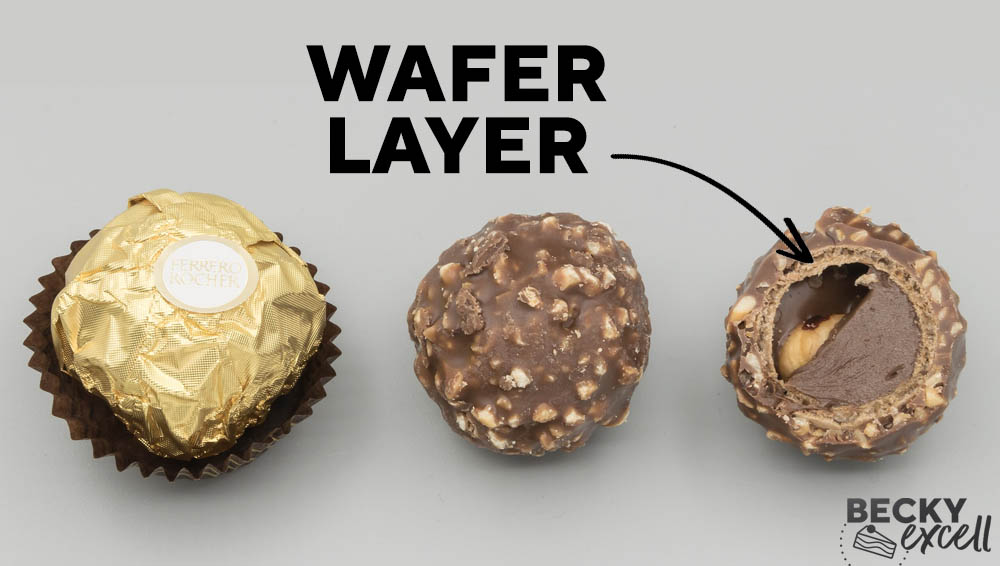
Image credit: By Jacek Halicki – Own work, CC BY-SA 4.0, https://commons.wikimedia.org/w/index.php?curid=141863729
Why are Ferrero Rocher not gluten-free?
As you can see from the ingredients list of a Ferrero Rocher below, that wafer layer is made from wheat flour. As wheat flour is a source of gluten, that means that Ferrero Rocher is a gluten-containing product.
As you can see in the ingredients list pictured, wheat flour is in bold to indicate it’s an allergen, making this product not suitable for Coeliacs or a gluten-free diet.
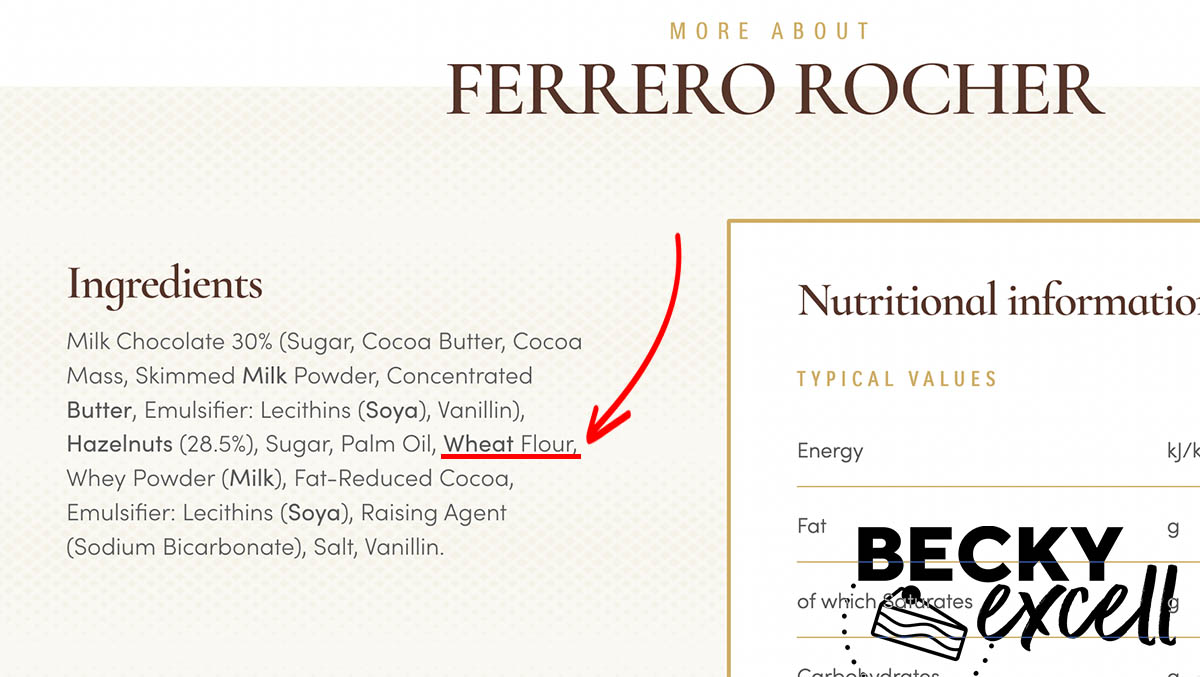
Ferrero Rocher Ingredients
Milk Chocolate 30% (Sugar, Cocoa Butter, Cocoa Mass, Skimmed Milk Powder, Concentrated Butter, Emulsifier: Lecithins (Soya), Vanillin), Hazelnuts (28.5%), Sugar, Palm Oil, Wheat Flour, Whey Powder (Milk), Fat-Reduced Cocoa, Emulsifier: Lecithins (Soya), Raising Agent (Sodium Bicarbonate), Salt, Vanillin.
Ferrero Rocher Website
Other allergens
Looking at the allergen list and what’s in bold, we can also see other allergens present in a Ferrero Rocher. This is useful for those who may need to avoid these ingredients for other reasons, such as being on a dairy-free diet or having a nut allergy. Whilst these other allergens have nothing to do with the product being gluten-free or not, we can also use these bolded words to determine that Ferrero Rocher also contains sources of dairy (skimmed milk powder, concentrated butter, whey powder), nuts (Hazelnuts) and soya or soy (Lecithins).
This means that Ferrero Rocher are not dairy-free and not suitable for vegans as they contain milk sources. Ferrero Rocher are also not nut-free due to the hazelnuts present. Ferrero Rocher are also not soy or soya free due to the lecithins present.
Remember: in the UK, allergens don’t necessarily need be in bold in the ingredients list of packaging, but they should be emphasised or highlighted in some way: often bolded, IN ALL CAPITALS or italicised. According to the UK Food Standards agency:
Allergenic ingredients must be emphasised in some way every time they appear in the ingredients list.
Food Standards Agency Website: Allergen labelling for food manufacturers
It doesn’t state that the allergens necessarily always need to be shown in bold – they just must be emphasised in some way.
Don’t forget that also, on a gluten-free diet, you’ll need to avoid any products with a ‘may contain’ warning for sources of gluten too, like barley or wheat etc. in conjunction with products that have gluten-containing ingredients present. See my guide on how to find gluten-free products here for more general information on identifying safe gluten-free products.
What are the gluten-free alternatives to Ferrero Rocher?
Today is your lucky day because Schar make a gluten-free alternative to a Ferrero Rocher that tastes almost exactly the same. The gluten-free version of a Ferrero Rocher are called Schar Tempties – read on to find out where to find them. And hurry! Because it doesn’t look like they’ll be around for much longer.
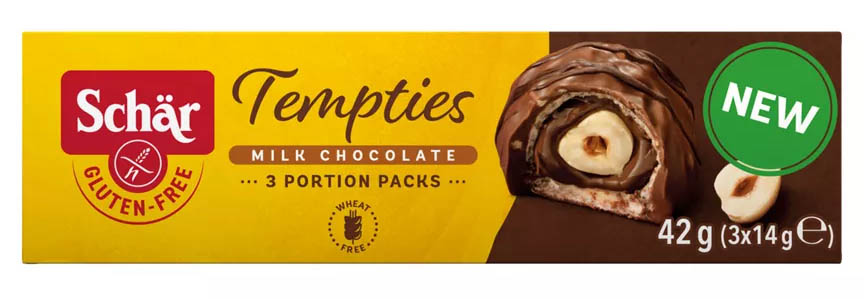
They used to be more widely stocked in most major UK supermarkets, however, right now I can only find them listed at Asda. As products come and go (and as I can’t even find these listed on Schar’s website anymore, it looks like they won’t be around for much longer), I’ll also link to my gluten-free Ferrero Rocher recipe where you can make your own.
Apart from this, there’s five Ferrero Rocher brand products which are gluten-free that I will now picture and link below:
- Ferrero Rocher Original Milk Chocolate Bar 90G
- Ferrero Rocher Hazelnut Dark 55% Chocolate Bar 90G
- Ferrero Rocher White Chocolate & Hazelnut Bar 90G
- Ferrero Rocher Grand Milk Chocolate Gift 125G
- Ferrero Rocher Grand Dark Chocolate Gift 125G
Note that the last two products aren’t ‘real’ Ferrero Rocher – they are oversized and hollow inside like Easter eggs! As we’ll soon learn from the impending disappearance of Schar’s Tempties, products do come and go, so bear that in mind if you suddenly can’t find these products anymore.
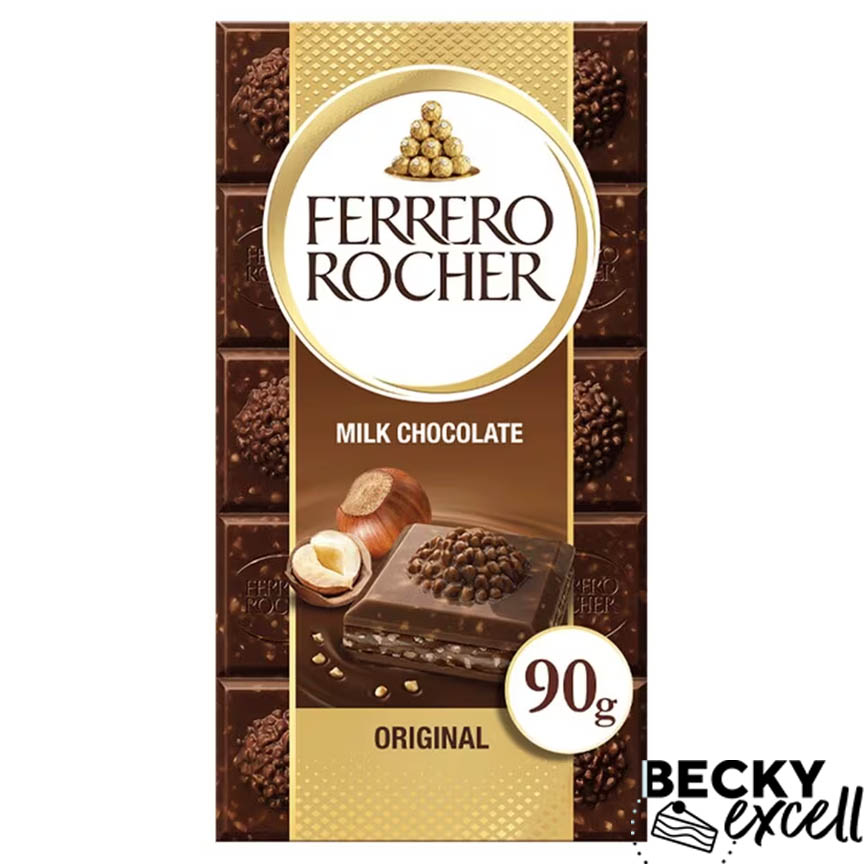
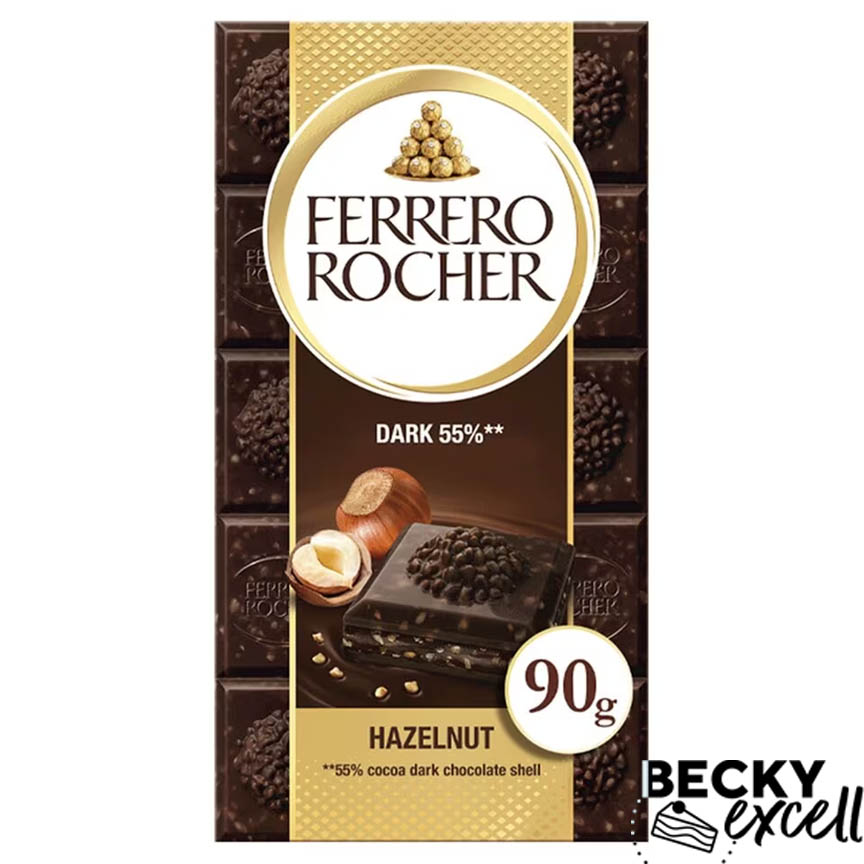
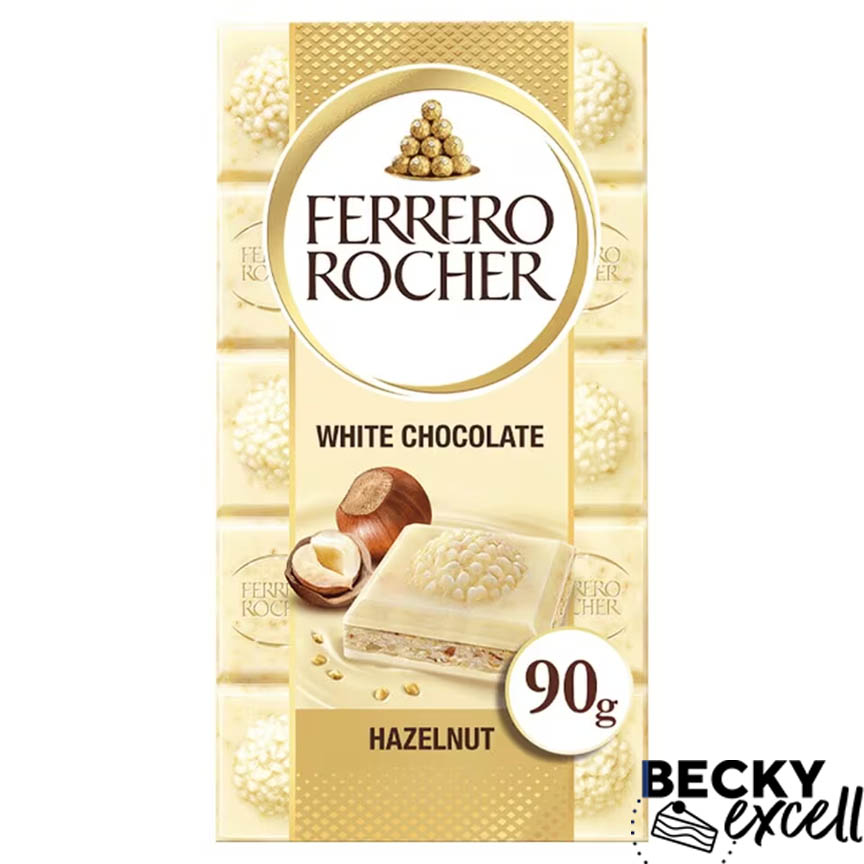
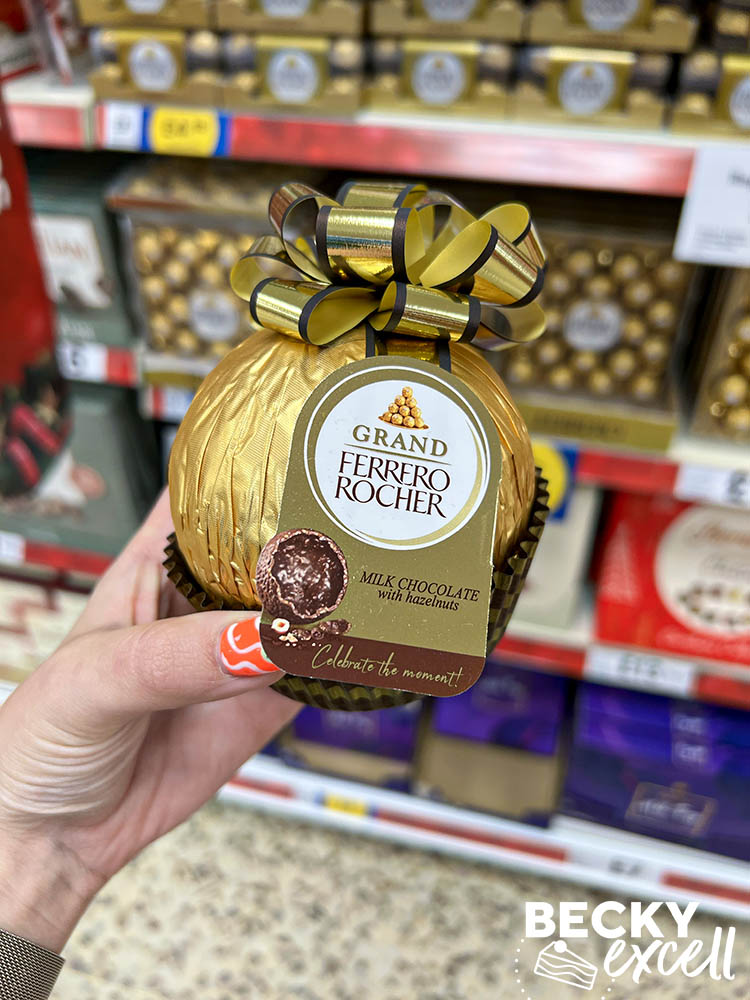


Please read: An important word of warning…
If you found this page via Google by searching something like ‘are Ferrero Rocher gluten-free?’, I need to issue an important but friendly word of warning to anyone who makes a regular habit of doing this…
Please be extremely careful when searching the Internet to try and find out if certain products are gluten-free or not and take your findings with a pinch of salt. Though search engines will always try and provide accurate search results, its pool of data might not always be up-to-date, or the information might pertain to the same product, but from a different country. And this is exactly why I make pages like this, so there’s accurate, up-to-date information out there for search engines like Google to pull from, hopefully ensuring that no gluten-free person gets the wrong information.
But though my intentions are pure, what if I made a page like this saying ‘yes, product x/y/z is gluten-free’ (like the gluten-free Ferrero Rocher alternatives I linked above) but in a year’s time, the ingredients quietly changed to contain wheat? Then, the information I provided would be incorrect until I noticed and updated it, but it would still incorrectly show on Google that the product is safe until that happens. And who knows how long it would take for me to notice and update the information? Or what if someone from another country found that page saying the product is safe to eat on a gluten-free diet, yet that product isn’t gluten-free in their country? I hope you’ll now understand why I’m writing this part!
That’s why my advice always remains the same: use information on the internet only to guide you to the physical product in person where you should check the ingredients list and allergen info or ‘may contain’ warnings for yourself, with your own eyes. It doesn’t matter what it says on the internet, even on the brand’s own website or supermarket listing – the packaging on the physical product is the definitive way to get an accurate answer to whether or not the product inside is gluten-free or not.
